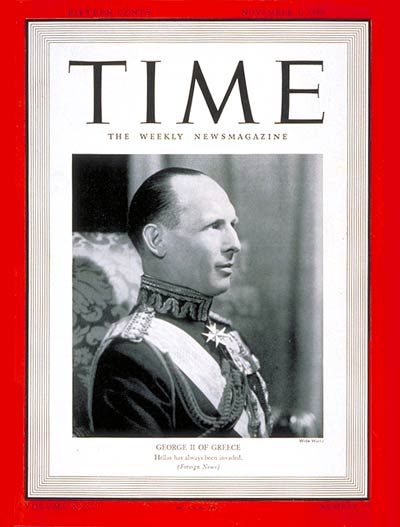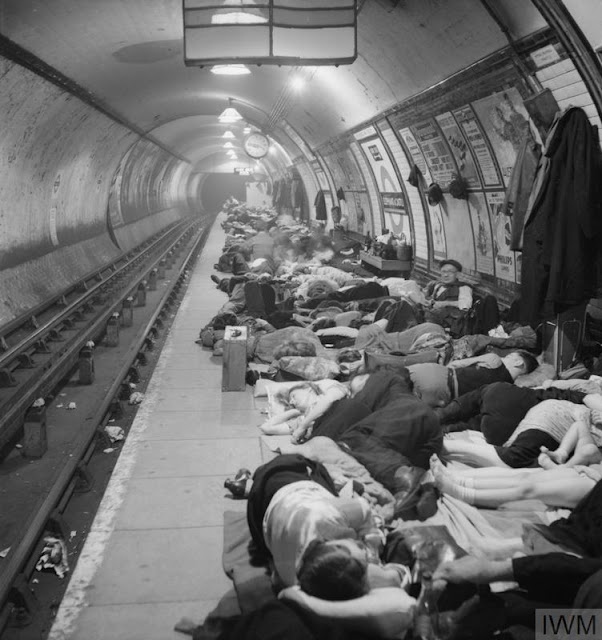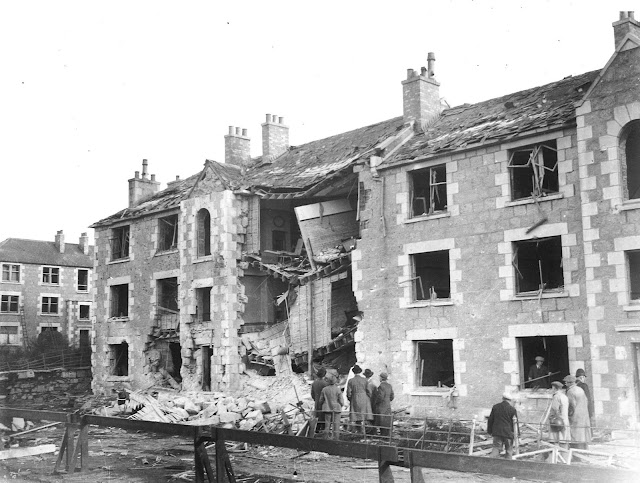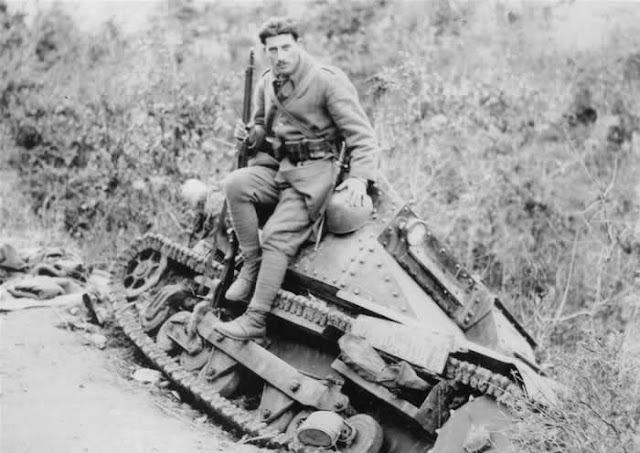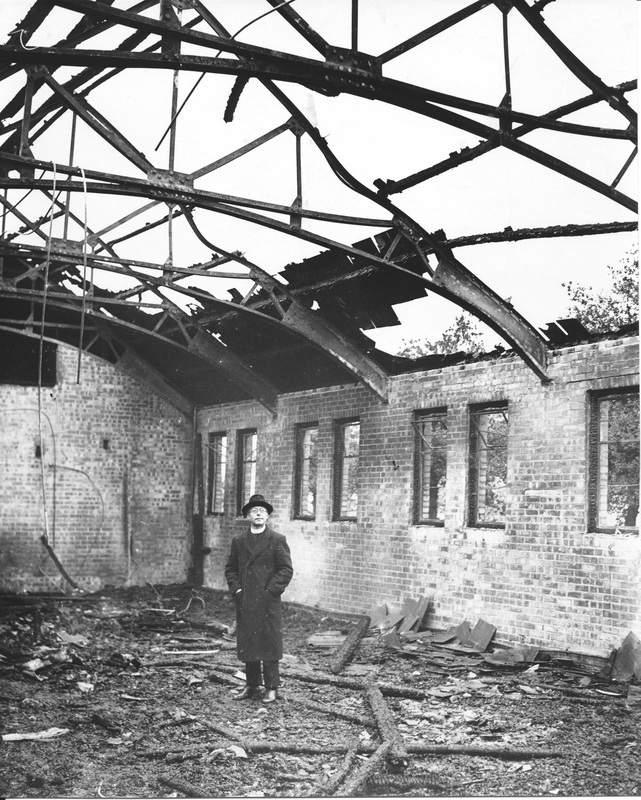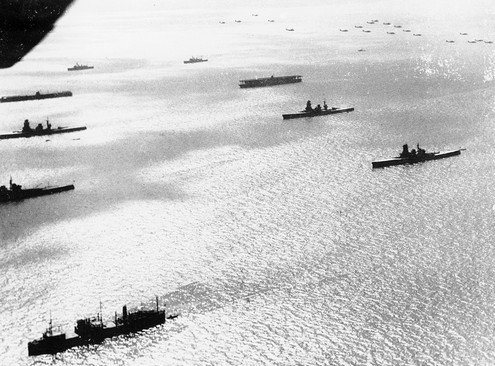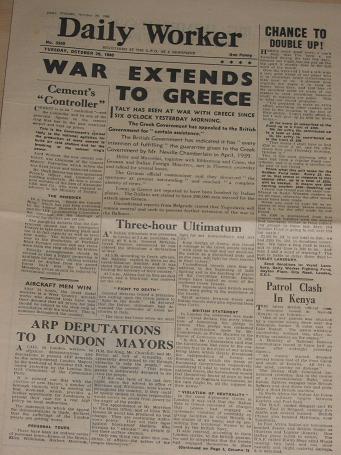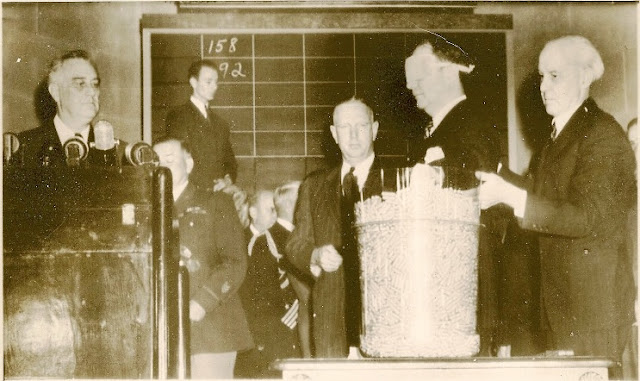Thursday 31 October 1940
 |
| British Supermarine Spitfire fighter aircraft (bottom) flying past a German Heinkel He-111 bomber (top) during the Battle of Britain. Since the Spitfire is trailing smoke, it may be in trouble itself. Bombers shot down a lot of fighters. |
Overview: Today,
31 October 1940, is when the British officially view the Battle of Britain as ending (date first established by a British Air Ministry pamphlet published in 1941). Just as their start date of 10 July 1940 is somewhat arbitrary, so too is this date. The Luftwaffe attacks continue, and the Germans retain the initiative throughout the winter. On the other hand, the likelihood of an invasion in 1940 has ended long ago, and there are few prospects for one in 1941. Hitler's wandering eye and strategic obligations to his allies, and the continuing inability of Fighter Command to subdue the Royal Air Force, rules out any kind of a repeat of the opportunities so briefly afforded during the summer of 1940. There was a brief window of opportunity to conquer England, and he walked right by it.
The ironic thing about the battle ending now is that the Germans finally have figured out a coherent strategy which, if pursued long enough and with enough vigor, conceivably could turn the battle in their favor. Fighter-bomber (Jabo) raids during the day and medium bomber waves at night is a winning formula - given the right targets. Combined with a heightened U-boat campaign, the battle conceivably could still turn in Germany's favor. Churchill always maintains that the real threat to England, the thing that worries him the most, is the economic strangulation posed by the U-boats. However, Hitler knows that his strength lies on land, not at sea and that quite accurate belief, ironically, will be his downfall.
 |
| This is a mapping based on data from original bomb census maps of bombs dropped on London during the Blitz. For the map's purposes (and not the RAF's) the Blitz is calculated to last from 10 July 1940 through 6 June 1941 (which is far more representative of damage caused than ending it at the end of October 1940). The map is interactive and shows the entirety of London, quite good fun to play with if you are interested in the Battle of Britain. |
Estimates for losses during the Battle of Britain (as defined by the British) vary wildly. If you were to take accounts from the media of the day, German losses would be several times what their records establish them to be. However, there is no question that the RAF soundly trounced the Luftwaffe over England.
- Luftwaffe losses (approximate): 1733-2200 planes, 3893 men
- RAF losses (reasonably certain): 544-828 planes 1007 men
These figures, incidentally, are constantly changing. I have seen figures as high as 1100+ for RAF planes lost. Generally, more recent figures have the loss ratio much closer than earlier figures. Eventually, historians easily could conclude that both sides lost the same numbers of planes - the figures have changed that much. If I can make a parenthetical observation, it is extremely unlikely that the Luftwaffe lost 2000 planes, considering that they only began the campaign with about that many planes (some estimates say 2800) and the German factories were hardly producing fast enough at this time to cover those kinds of losses. Many planes made it back to France smoking like a chimney but were repaired and sent up again. So, to be realistic, it is probably wise to take any official estimates and ratchet up the RAF losses and ratchet down the Luftwaffe ones.
However - and this is a huge "however" - the Luftwaffe lost the vast majority of pilots and aircrew that were shot down (yes, some were picked up by the very efficient Luftwaffe He-59 air-sea rescue crews). The RAF lost a much smaller fraction of its personnel to death and severe injury. This was the real damage to the Luftwaffe, not the number of planes lost (many of which would soon have been replaced by better models anyway). The Luftwaffe was never really short of planes, even during the war's last days: the constraining factors were trained pilots and, most importantly, fuel. Losing all those great pilots was the real cost to Germany of the battle - well, that and the anger from Hades unleashed upon them by killing so many civilians essentially to no purpose.
To the British side of the loss-ledger should be added the cities ruined, the civilian lives lost, the businesses destroyed, the families separated, the ships sunk, the bombers lost over Europe, and many other costs to which the war summaries pay lip service. The Luftwaffe dropped over 35,000 tons of bombs on Great Britain. London was attacked 19 times by 18,800 tons of bombs, razing 16,000 houses, damaging 130,000 others and making 60,000 uninhabitable. The worst area hit was the East End. All of this damage to England evens the "score" between the two sides somewhat, but destroying houses and killing women and children brought the Luftwaffe no closer to victory and made any talk of peace talks political suicide in England.
The Battle of Britain was won by the pilots, and they came from throughout the British Empire. 595 of the RAF pilots were non-British:
- 145 pilots from Poland
- 127 from New Zealand
- 112 from Canada
- 88 from Czechoslovakia
- 28 from Belgium
- 32 from Australia
- 25 from South Africa
- 13 from France
- 10 from Ireland
- 7 from America
- 1 from each of Jamaica, Palestine, and Rhodesia.
It should be noted that virtually everyone then and now agrees that the best RAF pilots during the Battle of Britain were the Polish pilots who escaped before their country's surrender.
The most successful pilots of the Battle of Britain were Werner Molders and Adolf Galland of the Luftwaffe, both of whom had 50 victories to their credit (some earned previously) by the battle's conclusion. On the RAF side, Eric Stanley Lock had 21 victories by 31 October 1940 (he wound up with 26 confirmed and 8 probable kills). James Lacey - often erroneously reported as the top ace of the Battle of Britain - only shot down 18 during the battle itself. He wound up with 28 kills and four probable kills by 1945. Lacey's greatest feat was, like Galland, to be on duty on both the first day of the war and the last.
 |
| Eric Stanley Lock. This photo was taken sometime between 14 July 1941 and 3 August 1941; on the former date, Lock was credited with his 26th kill, and on the latter, he went missing off Calais after being forced down in the Channel by ground fire. Most likely, he had this photo taken immediately after his 26th victory to commemorate it. |
Battle of Britain: During the day itself, the weather is rough and little takes place. In fact, it is one of the quietest days since the campaign began. The day is occupied by reconnaissance and occasional raids, primarily on airfields at Bassingbourn, Poling, Lawford Heath, and Martlesham. The raids are primarily by lone "pirate" bombers and don't accomplish much.
The Royal Ordnance Factory at Glascoed, the British Portland Cement Company, and The Repairable Equipment Ltd Factory all took damage. The raids are so scattered and sparse that Fighter Command can't even vector in any fighters for a confrontation - the bombers slip in and out.
After dark, London and the Midlands are bombed, and mines are dropped in the Thames Estuary. The winds are so bad that they blow the German bombers off course. This causes most of the bombers to miss London - which shows how strong the winds. Other attacks on Birmingham also achieve little. London is bombed throughout the night, but sporadically, and only by a handful of bombers at a time.
For the first time in four months, neither side takes any combat casualties. The weather, though, does take something from both sides, so generally, it is accepted that the Luftwaffe lost 2 planes today in weather-related incidents and the RAF one.
 |
| A Spitfire making a pass by a Dornier Do 17 during the Battle of Britain. |
Italian/Greek Campaign: In the vital Pindus Mountains sector in the center of the line, the Italian troops struggle forward through the snow and icy rain. Their first objective (40 km off their initial front) is the town of Vovousa, which they have not yet reached and is only a stepping-stone to the key Greek supply crossroads of Metsovo. The Greek line is stabilizing and giving ground grudgingly. On the coastal sector, the Italians are still moving forward to reestablish contact with the Greeks who have withdrawn to the Kalpaki Line. At this point, the Italians are still giving the North African front priority over the Albanian one.
Most histories state that this is the day that the Italian advance "stalls." That is a little premature. Greek resistance is stiffening, but the Italians are still moving forward in the central and coastal sectors.
The British land forces on the islands of Lemnos and Crete.
Greek destroyers Spetsai and Psara, operating out of Patras, cruise up to Albania and bombard Italian positions there using their 120 mm guns. This incident and the looming presence of the Royal Navy (the British Mediterranean Fleet is operating to the south) helps to cause Italy to scrub its projected operation to occupy Corfu (there are other reasons as well, such as troops being diverted to other operations).
European Air Operations: There is no bombing activity by the RAF out of England owing to the poor weather. RAF Bomber Command in Egypt, however, stretches its operations to the maximum (so far) and bombs oil installations in Naples, Italy. Coastal Command attacks enemy shipping off Norway.
Battle of the Atlantic: Convoy stragglers are ships that have difficulty maintaining convoy speed (which already is slower than many captains would like, usually 5-10 knots). The convoy system is having a Darwinian effect on shipping, eliminating older and poorly maintained ships at the expense of newer, faster ships.
U-124 (Kptlt. Georg-Whilhelm Schulz), the "Edelweisseboot," is on its second patrol out of Lorient when it finds a straggler to Convoy HX 82 west of the Outer Hebrides. She torpedoes and sinks 1437 ton British bauxite/sundries freighter Rutland. There are 25-29 deaths (accounts vary) - all of her crew.
Royal Navy trawler HMT Wardour hits a mine and sinks in the North Sea. The 12 crew survive and are picked up by HMS Douglas.
Royal Navy motor torpedo boat MTB 16 (Lt P. F. S. Gould) hits a mine and sinks in the North Sea near Clacton-on-Sea, Essex. Another motor torpedo boat, MTB 22, is damaged.
British 1535 ton collier Hillfern hits a mine (apparently, or maybe it was a Luftwaffe attack, in the foul weather nobody is sure) and sinks about 35 miles off Kinnaird Head/Buchanness. There are 8 deaths.
German 433 ton trawler Aldebaran hits a mine and sinks in the Baltic near Liepāja, Estonia.
The Luftwaffe bombs and damages 5702-ton British freighter Starstone.
German raider Widder (Captain Helmuth von Ruckteschell), running on greatly reduced power due to issues with its engines, arrives at Brest after a long journey home. The Widder has had a very successful cruise, sinking 10 ships of 58,645 tons.
There are a couple of incidents that illustrate the complicated nature of Anglo/Gallic relations at the moment.
French destroyers Brestois, Bordelais, Simoun, Tempete and L'Alcyon sail through the Straits of Gibraltar to the Atlantic. HMS Griffin shadows the French flotilla, and Force H, led by battleship HMS Barham, leaves Gibraltar. The Admiralty is concerned that they might turn north toward England, but instead, they turn south and Force H returns to port.
French 5205 ton transport Congo, having departed on the 24th, is en route from Fort de France bound for Casablanca. It has aboard 1206 French naval officers and 53 other passengers. Royal Navy AMC Moreton Bay intercepts it and orders it to Freetown. The 1259 men on board, though, eventually are allowed to proceed to Casablanca by other means.
German battlecruiser Admiral Scheer leaves Stavanger, Norway to break out into the Atlantic.
German supply ship Rio Grande departs from Rio de Janeiro to replenish raider Thor and then head for France. She has to elude the Neutrality patrols and the Royal Navy.
Convoy OB 237 departs from Liverpool, Convoy FS 324 departs from Methil, Convoy HG 46 (51 ships) departs from Gibraltar.
During the month of October 1940, Allied losses due to U-boats and mines increase, while losses to surface raiders and aircraft decrease:
- Sunk by U-boat: 352,407
- Sunk by Aircraft: 8752
- Sunk by Raider: 32134
- Sunk by Mine: 32548
There is one U-boat lost. The month of October is considered perhaps the height of the first U-boat "Happy Time" of the war, exemplified by the catastrophes of Convoys SC 7 and HX 79.
To the Atlantic losses should be added 4 Allied ships of 24,721 tons lost elsewhere (including the Mediterranean).
At the end of the month, the Royal Navy has 50 destroyers under repair at various facilities including Portsmouth, Plymouth, the Tyne, the Humber, Rosyth, and Malta. This, coincidentally, is the same number of destroyers obtained from the US in the destroyers-for-bases deal.
U-74 (Kapitänleutnant Eitel-Friedrich Kentrat) is commissioned.
Royal Navy corvette HMCS Trillium (Lt.Cdr. R.F. Harris, RCNR) is commissioned.
Royal Navy submarine HMS Upholder (Lt. Malcolm D. Wanklyn) is commissioned.
 |
| Nehru in prison. |
Battle of the Mediterranean: Italian bombers attack the British base at Mersa Matruh with 26 bombers escorted by 37 fighters. The RAF also attacks Italian airfields.
South African Prime Minister Jan Smuts is flying home from a conference in Sudan when RAF fighters mistake his plane for Italian and attack it. The plane lands safely in Kenya.
The British establish the Combined Bureau in Cairo. It is staffed by specialists from Bletchley Park to handle Ultra decrypts, which are closely guarded.
Axis shipping losses for October 1940 in the Mediterranean are:
- 6 Axis ships (all Italian);
- 19,968 tons
The government of Malta reports on the results of the war during its first four months of the war with Italy. It finds that there have been distinct phases in the battle:
- First Stage: Italian SM 79 bombers attacked without escorts;
- Second Stage: Italian fighters made sweeps without bombers;
- Third Stage: Day bombings resumed with fighter escorts, including by Stuka dive-bombers.
Air activity, the reports also states, died down completely in October.
Battle of the Pacific: German raider Pinguin continues laying mines between Australia and Tasmania. It lays 40 mines off Hobart. Meanwhile, converted minelayer Passat lays another 40 mines in the Bass Strait.
India: The British government continues to crack down on Nationalists who are engaging in coordinated nonviolent protests. Jawaharlal Nehru gives a speech, is arrested, and ultimately is sentenced to four years of hard labor.
China: At the continuing Battle of South Kwangsi, the Japanese 22nd Army is under pressure and retreats to Chinhsien for evacuation to Hainan Island.
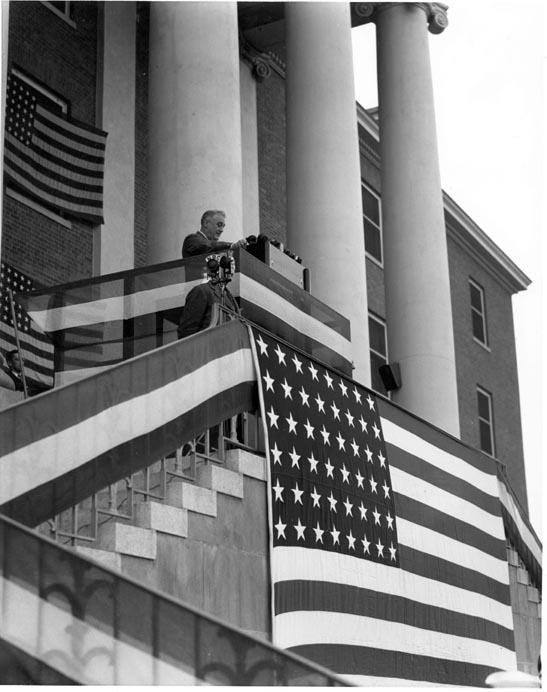 |
| President Franklin Roosevelt dedicates the new National Institute of Health campus at Bethesda, Maryland. |
October 1940 October 1, 1940: Wait Daddy October 2, 1940: Hitler's Polish PlansOctober 3, 1940: British Cabinet ShakeupOctober 4, 1940: Brenner Pass MeetingOctober 5, 1940: Mussolini Alters StrategyOctober 6, 1940: Iron Guard MarchesOctober 7, 1940: McCollum MemoOctober 8, 1940: Germans in RomaniaOctober 9, 1940: John Lennon ArrivesOctober 10, 1940: Führer-SofortprogrammOctober 11, 1940: E-Boats Attack!October 12, 1940: Sealion CancelledOctober 13, 1940: New World OrderOctober 14, 1940: Balham TragedyOctober 15, 1940: Mussolini Targets GreeceOctober 16, 1940: Japanese Seek OilOctober 17, 1940: RAF ShakeupOctober 18, 1940: Convoy SC-7 CatastropheOctober 19, 1940: Convoy HX-79 CatastropheOctober 20, 1940: Convoy OB-229 DisasterOctober 21, 1940: This Evil Man HitlerOctober 22, 1940: Aktion Wagner-BurckelOctober 23, 1940: Hitler at HendayeOctober 24, 1940: Hitler and PetainOctober 25, 1940: Petain Woos ChurchillOctober 26, 1940: Empress of Britain AttackOctober 27, 1940: Greece Rejects Italian DemandsOctober 28, 1940: Oxi DayOctober 29, 1940: US Draft BeginsOctober 30, 1940: RAF Area Bombing AuthorizedOctober 31, 1940: End of Battle of BritainNovember 1940 November 1, 1940: Hitler IrateNovember 2, 1940: U-31 Sunk - AgainNovember 3, 1940: Kretschmer's Master ClassNovember 4, 1940: Spain Absorbs TangierNovember 5, 1940: Jervis Bay Meets Admiral ScheerNovember 6, 1940: San Demetrio IncidentNovember 7, 1940: Galloping GertieNovember 8, 1940: Italian Shakeup in GreeceNovember 9, 1940: Dutch Fascists MarchNovember 10, 1940: Fala and Doc StrangeNovember 11, 1940: Taranto RaidNovember 12, 1940: Molotov Takes BerlinNovember 13, 1940: Molotov Foils HitlerNovember 14, 1940: Moonlight SonataNovember 15, 1940: Warsaw Ghetto SealedNovember 16, 1940: France Keeps BattleshipsNovember 17, 1940: Malta Hurricane DisasterNovember 18, 1940: Hitler Berates CianoNovember 19, 1940: Birmingham DevastatedNovember 20, 1940: Hungary Joins AxisNovember 21, 1940: Dies White PaperNovember 22, 1940: Italians Take KorçëNovember 23, 1940: U-Boat Bonanza!November 24, 1940: Slovakia Joins InNovember 25, 1940: Molotov's DemandsNovember 26, 1940: Bananas Be GoneNovember 27, 1940: Cape Spartivento BattleNovember 28, 1940: Wick PerishesNovember 29, 1940: Trouble in IndochinaNovember 30, 1940: Lucy and Desi Marry2020

